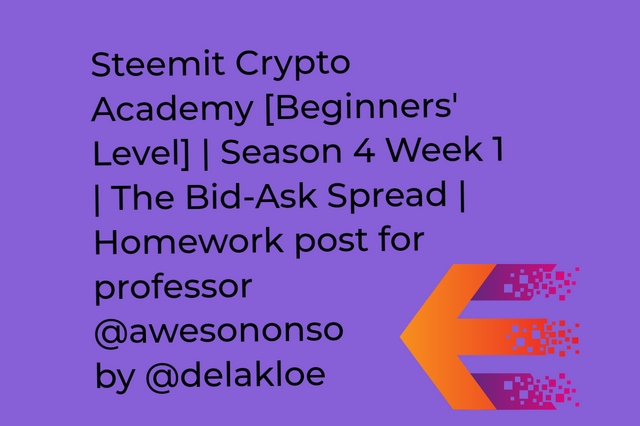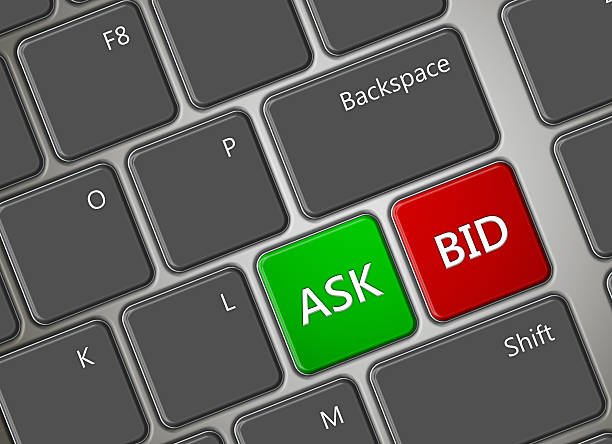Steemit Crypto Academy [Beginners' Level] | Season 4 Week 1 | The Bid-Ask Spread | Homework post for professor @awesononso

What is the bid-ask spread
The Bid ask spread is the difference between the highest price the buyer is willing to pay for the asset and the lowest price the seller is willing to accept for the transaction.
People who want to sell the claim will get the offer, while people who want to buy must pay the sale price.
Assets are all resources with economic value owned or controlled by certain people or countries in order to benefit in the future.
Assets can be interpreted as things that can generate income or cash, reduce expenses, etc. in the future. Understand the bid-ask spread The price of a commodity or security is the only market value allocated to a security or commodity at a given time.
To understand why there are "supply" and "demand", two major players in the market must be considered. Therefore, price takers and market makers.
Market makers, many of whom are employed by brokerage companies, provide quotes for selling securities at specific prices (quotes) and will also bid for securities at specific prices (quotes).
When investors initiate a transaction, they will accept one of these two prices, depending on whether they want to buy (sell price) or sell the security (sell price).
The difference between (bid) and (ask), that is, the spread, is the main transaction cost of the transaction, which is charged by the market maker at the buying and selling price through the normal order processing process. This is why brokerage companies mainly claim that their income comes from traders who "pass the customs". The bid-ask spread is called an indicator to measure the supply-demand relationship of a specific asset.
Since supply can be said to represent demand, and demand also represents the supply of assets, when these two prices expand along this line, price behavior reflects changes in supply and demand.
The depth of the "offer" and "request" has a very important impact on the bid bond. If fewer participants place limit orders to buy securities, or if fewer sellers place limit orders to sell, the spread may widen significantly.
Therefore, it is important to understand the bid-ask spread of the upcoming limit ordeñ this with a certain security, then the indicated bid-ask spread will reflect a larger scale. Some high-frequency professionals and market makers try to make money by using changes in spreads.
Why is the Bud-Ask Spread important
The bid-ask spread is an important barometer of the liquidity of any stock. Generally, the more liquid a stock is, the more active it changes hands and the more reasonable the price.
Highly liquid stocks that are part of Nifty and Sensex have very low bid-ask spreads because they have sufficient liquidity.
The bid-ask spread is an indicator of the risk of stock trading. For example, the idea of executing a purchase or order in the market is to get the stock as close to the best price as possible.
The higher the bid-ask spread, the greater the risk of trading stocks, which will bring indirect costs to the transaction. Although the cost of spreads is not directly measured as a broker, they incur high costs over a longer period of time.
The bid and ask margin is a guide for the type of order placed. Generally, if the bid-ask spread is small, you can get the best price through the market order itself. However, if the spread is higher, the limit order will be a better option.
The narrowing and widening of the bid-ask spread indicates the direction of market movement. The operation can be modified accordingly
If Crypto X has a bid price of $5 and an ask price of $5.20,
a.) Calculate the Bid-Ask spread.
b.) Calculate the Bid-Ask spread in percentage.
For Crypto X
Bid-Ask Spread= Ask-Bid
Ask= $5.20
Bid=$5
=$5.20-$5
=$0.20
b. %Spread=spread÷Ask×100%
=$0.20÷$5.20×100%
=0.0384615385×100%
= 3.8461538462%
If Crypto Y has a bid price of $8.40 and an ask price of $8.80,
a.) Calculate the Bid-Ask spread.
b.) Calculate the Bid-Ask spread in percentage.
For crypto Y
Bid= $8.40
Ask= $8.80
Bid-Ask Spread= $8.80-8.40
=$0.40
b. %Spread= $0.40÷8.80×100%
=0.0454545455×100%
=4.5454545455%
In one statement, which of the assets above has the higher liquidity and why?
From the calculations from above, it can be proven that crypto X has a Bid-Ask Spread of $0.20 and so it has more liquidity than crypto Y with $0.40. This is possible because more liquidity market have smaller or lower spreads.
What is slippage
Slippage refers to all situations where market participants receive transaction execution prices that are different from expectations. Slippage occurs when the bid-ask spread changes between the requested market order and the execution of the order by the exchange or other market makers.
One of the most common ways of slippage is a sudden change in the bid-ask spread. When this happens, market orders can be executed at a lower or more favorable price than originally anticipated.
Slippage does not represent negative or positive movements because the difference between the expected execution prices and the real execution prices is slippage. When an order is executed, security is purchased or sold at the most favorable price provided by the exchange or other market manufacturer. This provides a preferred, equal or good result than the expected execution price.
Final execution prices and the intended execution prices can be classified as positive or negative slippage. Market prices can be changed quickly and can occur when slippage occurs when delayed between orders and when completed. This term is used in many market places, but the definition is the same.
However, Slippage tends to occur in different situations for each place. The restriction order prevents negatives slippage, but if the price does not return to the level of limit, trade has a risk that trade is not running.
This risk will increase the fluctuations of the market faster and more significantly, it will significantly limit the moment when the transaction is completed in the expected execution price
For negative slippage, the demand for long trades increases or the supply for short trades decreases.
For positive slippage, the sell price on a long trade decreases or the bid price on a short trade increases.
Market participants can protect themselves from slippage by placing limit orders and avoiding market orders. For example, suppose Apple's buy sell price is advertised on the broker interface as $ 183.50 / $ 183.53. A market order for 100 shares was placed with the intention of trading at US $ 183.53. However, before the order was completed, the microsecond transaction of the computer program increased the bid-ask spread to $ 183.54 / $ 183.57. The order is then executed at $183.57, resulting in $0.04 per share or $4.00 per 100 shares of negative slippage.
There are three types of slippage in transactions. The first is positive slippage, that is, the opening or closing price of the price is higher than the expected level in the eyes of traders. For example, when the transaction begins, the price will be lower than the price the merchant intends to open, providing more value.
No slip As the name implies, no slippage means that the market price opens or closes at the expected, expected and exact price. This is the most common form of slippage because most transactions will be executed at the expected price. However, "non-slip" is not a term often used to refer to these operations, because it is just a specification.
Negative slippage The last form of slippage is negative slippage. This is where the trader loses value because the execution price is lower than the expected price. 2. Examples of slippage Example 1 (negative slippage when opening a position) A trader intends to trade with Amazon at a price of 100.00 and clicks to open a long position at that price.
However, when the transaction is executed, the price "falls" and Amazon's position opens at 101.00, which is the new price it rises to. Example 2 (negative slippage occurs when closing a trade) A trader wants to sell Facebook for 100.00 and then clicks to close his open position.
However, the price at the time of execution at the end of the transaction fell to 99.00, so in this case, the trader lost one point of value. Example 3 (Positive slippage when opening a position) A trader wants to buy gold at a price of 250.00. When opening a position, the execution price is 240.00, which means that the trader opens the position at a price 10 points lower than the expected price of the same transaction. Example 4 (Positive slippage when closing a position) A trader intends to trade with Apple and close the position at 250.00.
However, the execution price for closing the position is 280.00, which means that the trader has benefited from the 30-point slippage. Example 5 (no slippage when opening a position) A trader intends to open a long position on Facebook, and then clicks to buy at a price of 400.00.
The transaction is executed at 400.00, which means that there is no loss or value at the expected price.
Conclusion
Bid-Ask spread is an important aspect in the market for traders. Smaller Spread signifies Lower risk and liquid market while larger spread are less liquid and is very risky.
I want to thank professor @awesononso for the amazing lecture. Thank you
CC.
Professor @awesononso
